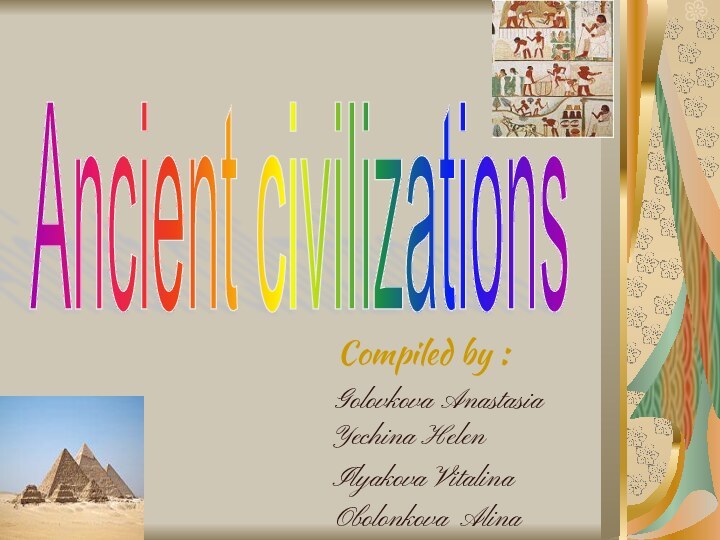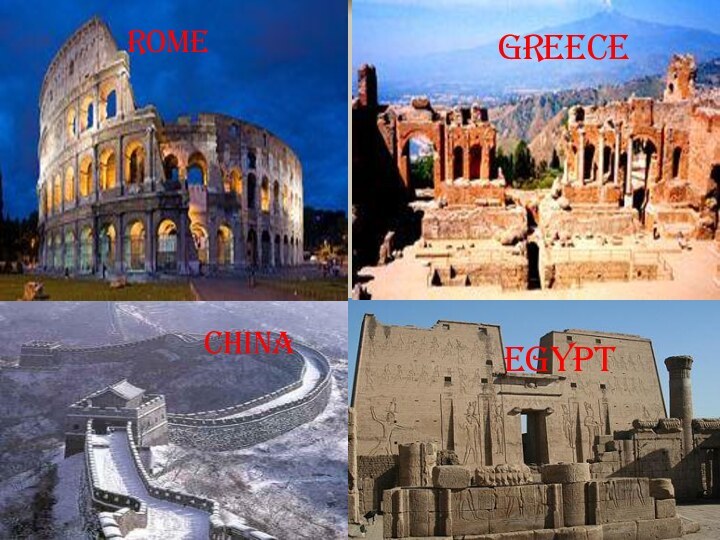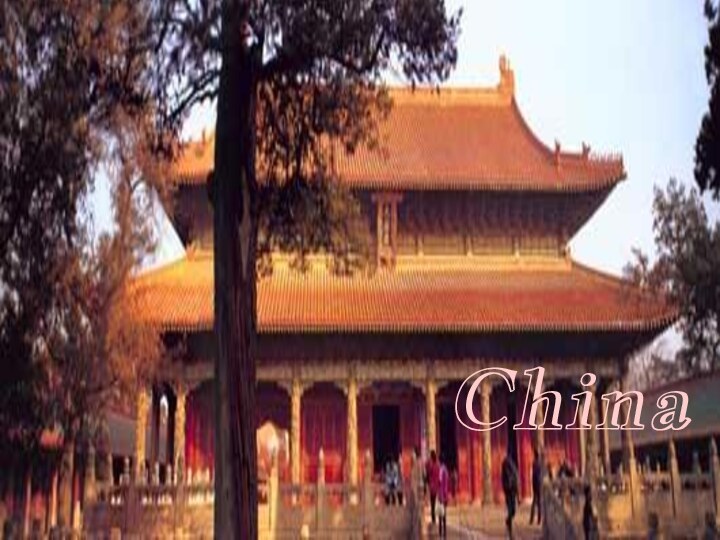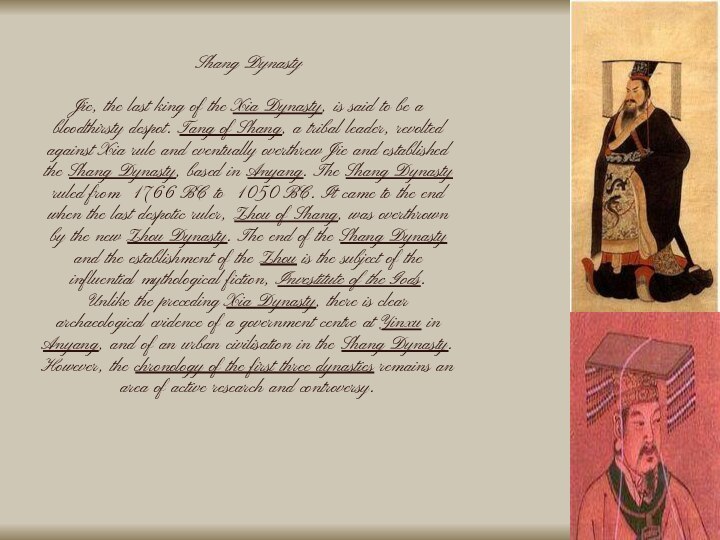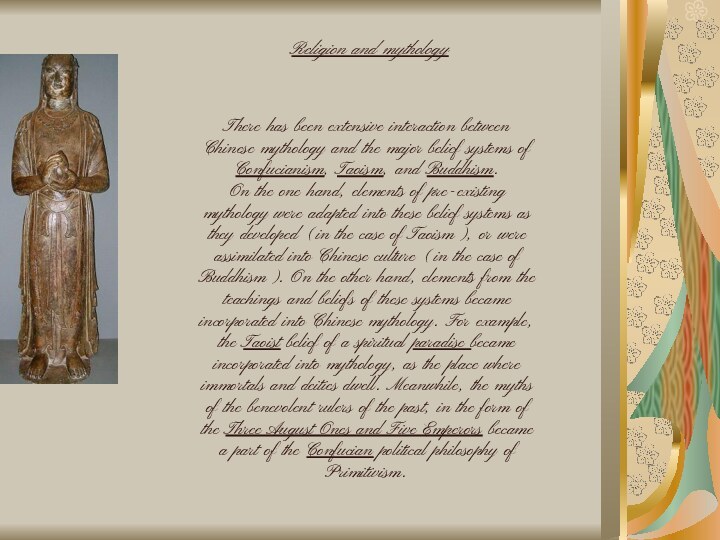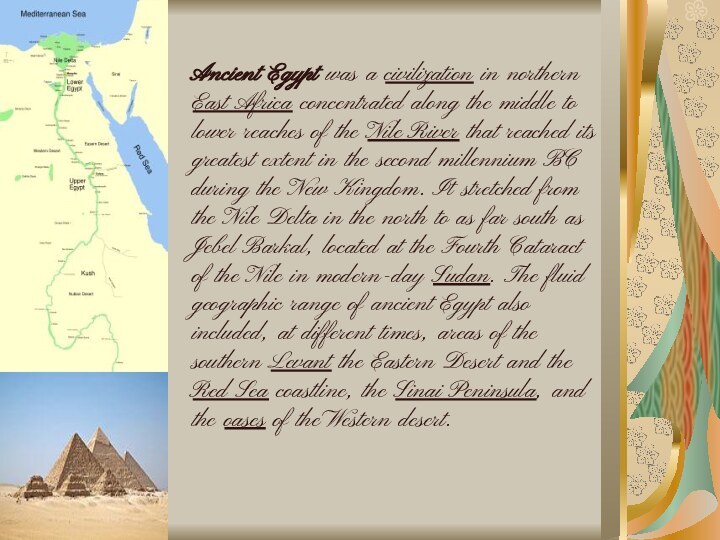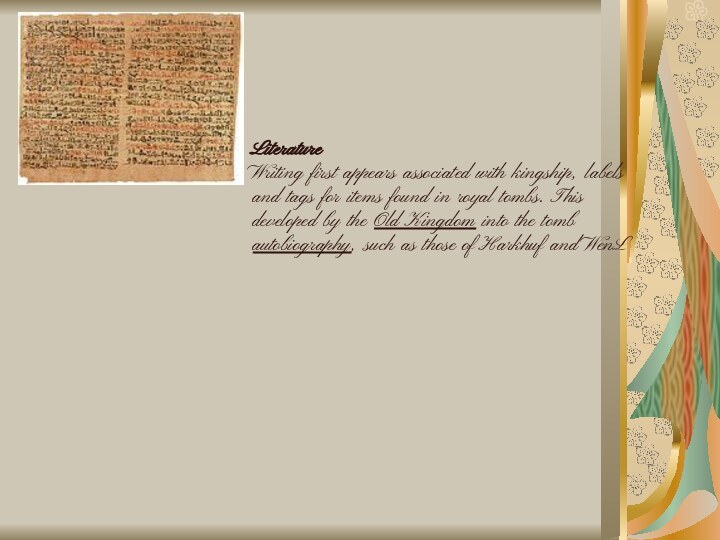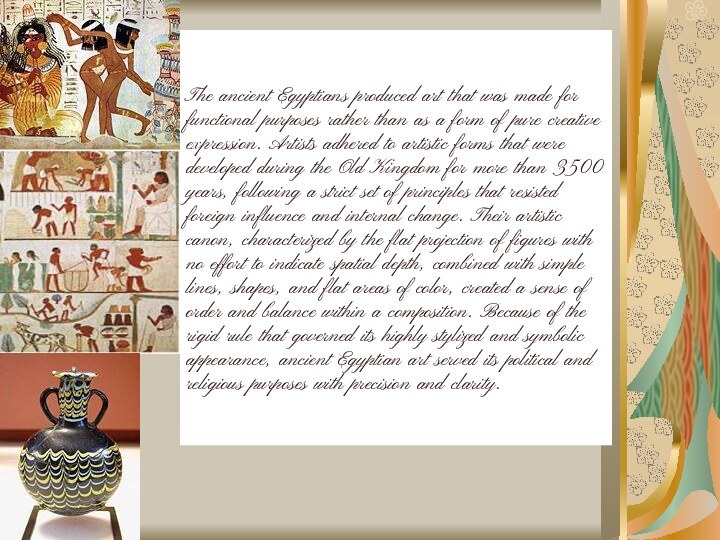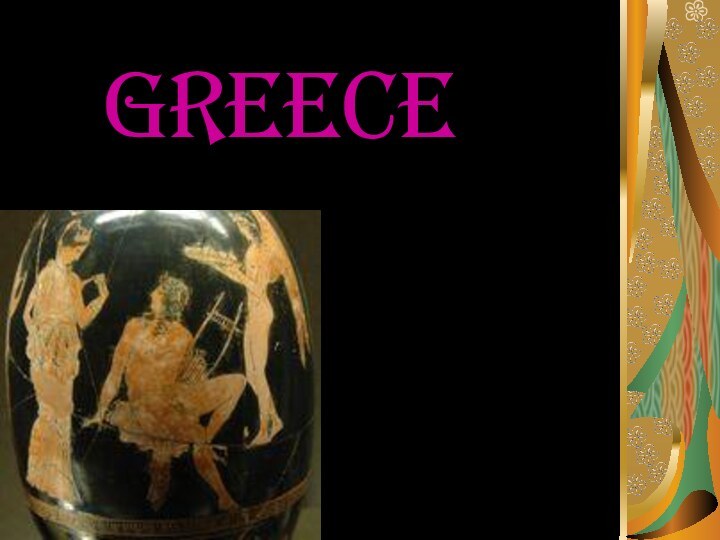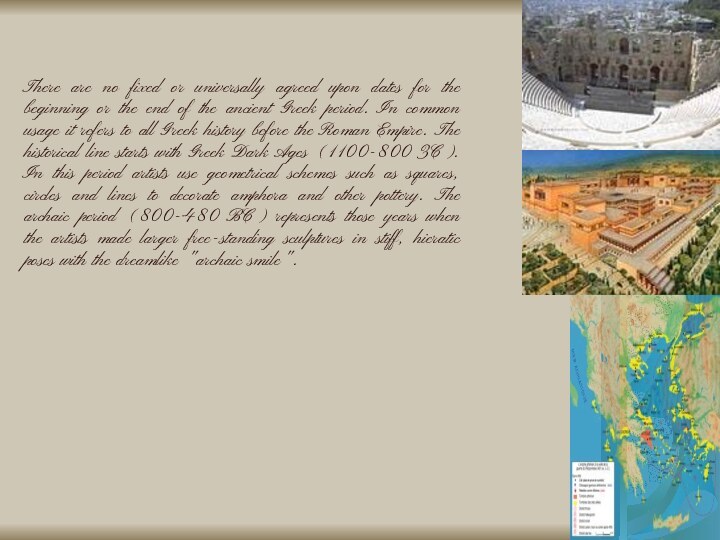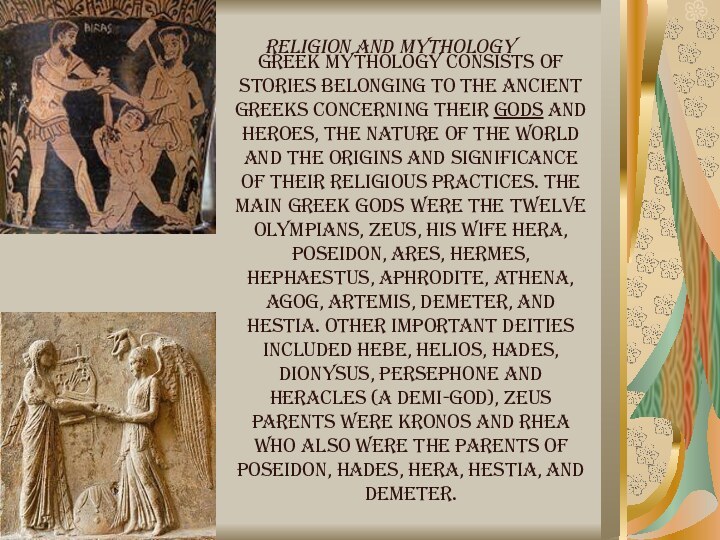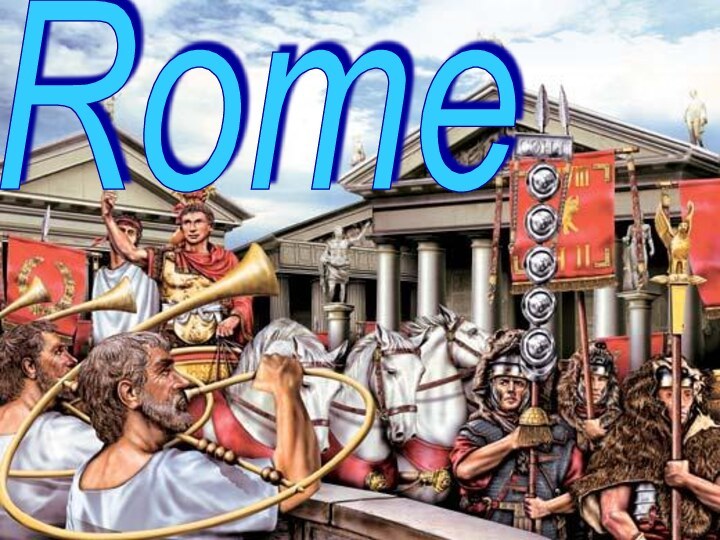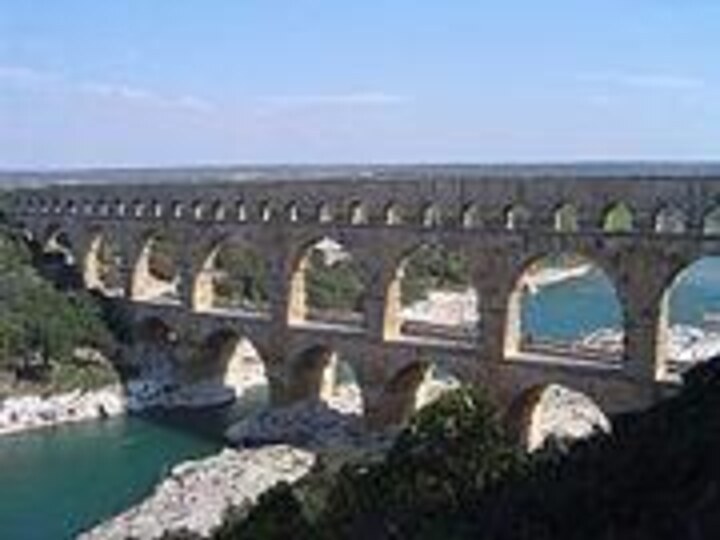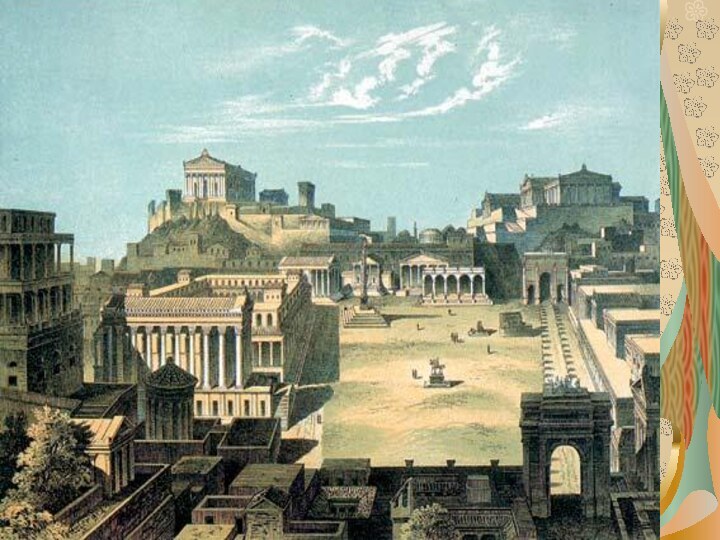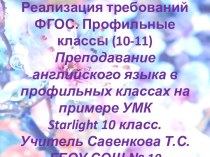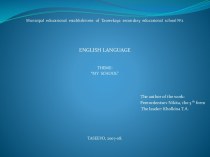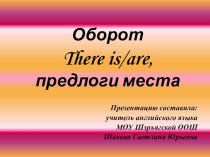Слайд 4
A number of works record ancient Chinese mythology

in their settled forms. Most myths extant today are
derived from their recording in these works.
Shan Hai Jing - Literally Mountain and Sea Scroll, the Shan Hai Jing describes the myths, witchcraft, and religion of ancient China in great detail and also has a record of the geography, sea and mountains, history, medicine, customs, and ethnicities in ancient
times. It has been called an early encyclopedia of China.
Shui Jing Zhu - Literally Commentaries on the Water Scroll, this work began as commentaries on the briefer work of the Water Scroll, but became famous of its own
accord because of its extensive record of geography, history, and associated legends.
HeVan Zhuan - Epic of Darkness Literally Epic of the Darkness,this is the only
collection of legends in epic form preserved by a community of the Han nationality of
China, namely, inhabitants of the Shennongjia mountain area in Hubei, containing
accounts from the birth of Pangu till the historical era.
Records of Myths
Слайд 5
Myths and Legends
Great Flood
Shun passed his place as
leader of the Huaxia tribe to Yu the Great.
According to legend, the Yellow River was prone to flooding, and erupted in a huge flood in the time of Yao. Yufs father, Gun, was put in charge of flood control by Yao,
but failed to alleviate the problem after 9 years. He was executed by Shun, and Yu took his father's place, and led the people in building canals and levees. After thirteen years of toil, flooding problems were solved under Yu's command. Shun enfeoffed Yu in the place of Xia, in present-day Wan County in Henan. On his death, Shun passed the leadership to Yu. The main source for the story of Yu and the Great Flood comes from The Counsels of Yu the Great in the Classic of History.
Because of his achievement in resolving the Great Flood, Yu, alone among the mythological rulers, is usually called "Yu the Great". Alternatively, he is called Emperor Yu, like his predecessors.
Слайд 6
Xia Dynasty
Upon Yu's death, his position as leader
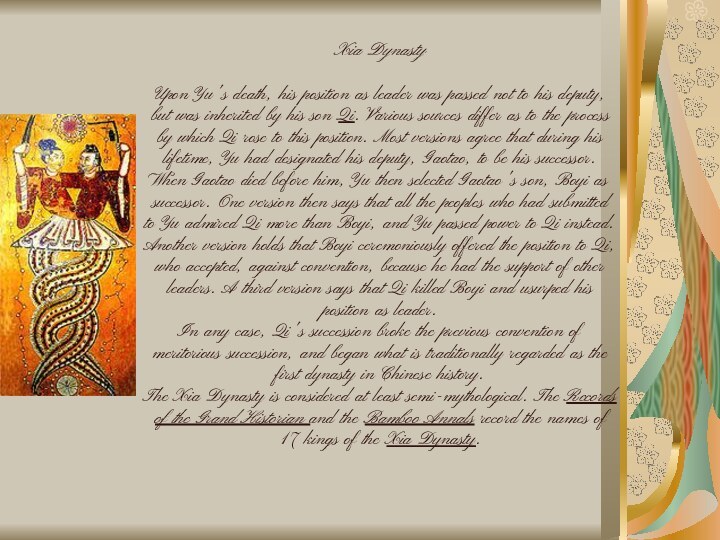
was passed not to his deputy, but was inherited
by his son Qi. Various sources differ as to the process by which Qi rose to this position. Most versions agree that during his lifetime, Yu had designated his deputy, Gaotao, to be his successor. When Gaotao died before him, Yu then selected Gaotao's son, Boyi as successor. One version then says that all the peoples who had submitted to Yu admired Qi more than Boyi, and Yu passed power to Qi instead. Another version holds that Boyi ceremoniously offered the position to Qi, who accepted, against convention, because he had the support of other leaders. A third version says that Qi killed Boyi and usurped his position as leader.
In any case, Qi's succession broke the previous convention of meritorious succession, and began what is traditionally regarded as the first dynasty in Chinese history.
The Xia Dynasty is considered at least semi-mythological. The Records of the Grand Historian and the Bamboo Annals record the names of 17 kings of the Xia Dynasty.
Слайд 7
Shang Dynasty
Jie, the last king of the Xia
Dynasty, is said to be a bloodthirsty despot. Tang
of Shang, a tribal leader, revolted against Xia rule and eventually overthrew Jie and established the Shang Dynasty, based in Anyang. The Shang Dynasty ruled from 1766 BC to 1050 BC. It came to the end when the last despotic ruler, Zhou of Shang, was overthrown by the new Zhou Dynasty. The end of the Shang Dynasty and the establishment of the Zhou is the subject of the influential mythological fiction, Investitute of the Gods.
Unlike the preceding Xia Dynasty, there is clear archaeological evidence of a government centre at Yinxu in Anyang, and of an urban civilisation in the Shang Dynasty. However, the chronology of the first three dynasties remains an area of active research and controversy.
Слайд 8
There has been extensive interaction between Chinese mythology
and the major belief systems of Confucianism, Taoism, and
Buddhism.
On the one hand, elements of pre-existing mythology were adapted into these belief systems as they developed (in the case of Taoism), or were assimilated into Chinese culture (in the case of Buddhism). On the other hand, elements from the teachings and beliefs of these systems became incorporated into Chinese mythology. For example, the Taoist belief of a spiritual paradise became incorporated into mythology, as the place where immortals and deities dwell. Meanwhile, the myths of the benevolent rulers of the past, in the form of the Three August Ones and Five Emperors became a part of the Confucian political philosophy of Primitivism.
Religion and mythology
Слайд 9
Chinese art has varied throughout its ancient history,
divided into periods by the ruling dynasties of China
and changing technology. Different forms of art have been influenced by great philosophers, teachers, religious figures and even political leaders. Chinese art encompasses fine arts, folk arts and performance arts.
Слайд 11
Ancient Egypt was a civilization in northern East
Africa concentrated along the middle to lower reaches of
the Nile River that reached its greatest extent in the second millennium BC during the New Kingdom. It stretched from the Nile Delta in the north to as far south as Jebel Barkal, located at the Fourth Cataract of the Nile in modern-day Sudan. The fluid geographic range of ancient Egypt also included, at different times, areas of the southern Levant the Eastern Desert and the Red Sea coastline, the Sinai Peninsula, and the oases of the Western desert.
Слайд 13
Architecture
The architecture of ancient Egypt includes some
of the most famous structures in the world, such
as the Great Pyramids of Giza, Abu Simbel and the temples at Thebes. All major building projects were organized and funded by the state, whose purpose was not only to provide functional religious, military, and funerary structures but to reinforce the power and reputation of the pharaoh and ensure his legacy for all time. The ancient Egyptians were skilled builders with expert knowledge of basic surveying and construction techniques. Using simple but effective measuring ropes, plum bobs, and sighting instruments, architects could build large stone structures with accuracy and precision.
Слайд 14
Art
The ancient Egyptians produced art that was made
for functional purposes rather than as a form of
pure creative expression. Artists adhered to artistic forms that were developed during the Old Kingdom for more than 3500 years, following a strict set of principles that resisted foreign influence and internal change. Their artistic canon, characterized by the flat projection of figures with no effort to indicate spatial depth, combined with simple lines, shapes, and flat areas of color, created a sense of order and balance within a composition. Because of the rigid rule that governed its highly stylized and symbolic appearance, ancient Egyptian art served its political and religious purposes with precision and clarity.
Слайд 16
There are no fixed or universally agreed upon
dates for the beginning or the end of the
ancient Greek period. In common usage it refers to all Greek history before the Roman Empire. The historical line starts with Greek Dark Ages (1100-800 3C). In this period artists use geometrical schemes such as squares, circles and lines to decorate amphora and other pottery. The archaic period (800-480 BC) represents those years when the artists made larger free-standing sculptures in stiff, hieratic poses with the dreamlike "archaic smile".
Слайд 17
Greek mythology consists of stories belonging to the
Ancient Greeks concerning their gods and heroes, the nature
of the world and the origins and significance of their religious practices. The main Greek gods were the twelve Olympians, Zeus, his wife Hera, Poseidon, Ares, Hermes, Hephaestus, Aphrodite, Athena, Agog, Artemis, Demeter, and Hestia. Other important deities included Hebe, Helios, Hades, Dionysus, Persephone and Heracles (a demi-god), Zeus parents were Kronos and Rhea who also were the parents of Poseidon, Hades, Hera, Hestia, and Demeter.
Religion and mythology
Слайд 18
Mythology was at the heart of everyday life
in ancient Greece. Greeks regarded mythology as a part
of their history. They used myth to explain natural phenomena, cultural variations, traditional enmities and friendships. It was a source of pride to be able to trace one's leaders' descent from a mythological hero or a god.
Слайд 20
The Architecture of Ancient Rome adopted the external

language of classical Greek architecture for their own purposes,
which were so different from Greek buildings as to create a new architectural style.
Certainly, the Romans absorbed Greek influence in many aspects closely related to architecture, for example in the introduction and use of the Triclinium in Roman villas as a place and manner of dining. But at this point so too should we note Roman indebtedness to their Etruscan neighbours and forefathers who supplied them with a wealth of knowledge essential for their future architectural solutions, for example in terms of hydraulics and in the construction of arches. Adopting this broader view of architecture we can see that social elements such as wealth and high population densities in cities forced the ancient Romans to discover new (architectural) solutions of their own. For example, the use of vaults and arches together with a sound knowledge of building materials enabled them to achieve unprecedented successes in the construction of imposing structures for public use. Examples include the aqueducts, the Pantheon, Rome (largest single span dome for well over a millennium), the basilicas and perhaps most famously of all, the Coliseums.
